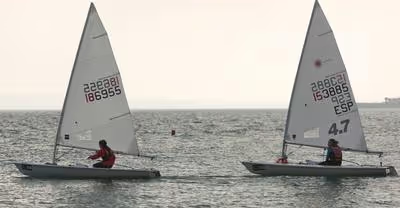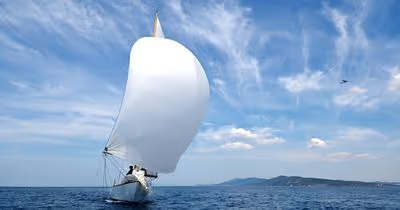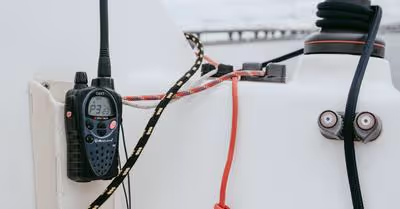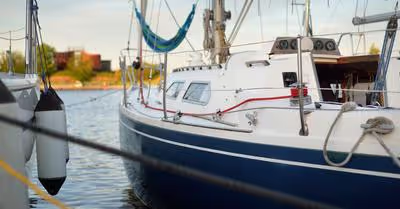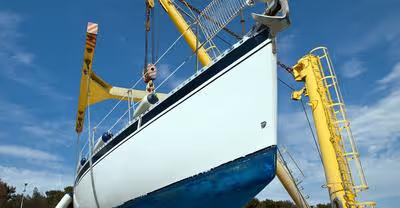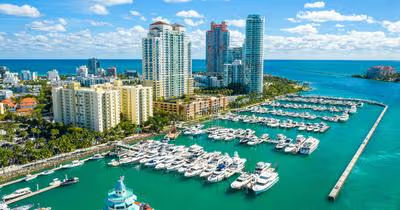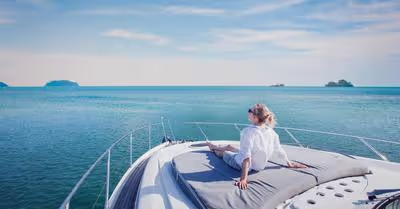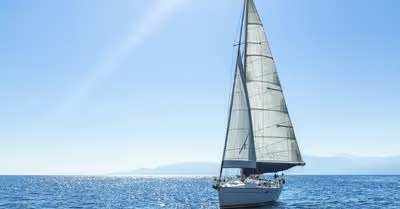Table of Contents
Sea Lanes From California to Hawaii
Whether you are embarking from San Francisco, Los Angeles, or San Diego — or Oregon or Seattle for that matter — you will follow the same general route. In my experience, the best route to follow is to sail south trailing the coastline of the Pacific states to 35° N – 25° N before you turn west and make way for the islands.
As you can see, the best general sailing route is not a straight sail to Hawaii. This is because of the Pacific currents along the Pacific Coast that run from north to south. Taking this path will ensure smooth sailing and will help you avoid the strong countervailing winds that you will encounter when taking a direct path to Hawaii.
Another route that you can take is to sail southerly to Los Angeles and then take a west course to Hilo.
Here are some other ways you can make a southerly trip from California:
- The fastest route is to follow the coastline at about 20 to 40 miles out. This will allow you to capitalize on the Pacific currents and wind and increase your speed.
- If you want to play it safe, I recommend sailing offshore at 50 to 100 miles out. This will offer smooth sailing and less ocean traffic but you might encounter the Pacific High, which means poor winds and light rain. The North Pacific High is an anticyclone region in the ocean that is responsible for California’s dry summers and fall and wet spring and winter. It is also responsible for the consistent trade winds in Hawaii. If you end up here, your vessel may slow down, increasing the time to reach your destination.
- You can also trail along the coastline, hopping from port to port, until you reach San Francisco. You can then make an east heading. However, this is a very slow route.
When going on an ocean journey, make sure your navigation system is in perfect working order as you will encounter various shipping lanes. In addition, you need to watch out for potentially dangerous sites including Cape Blanco, Cape Flattery, Point St George, Honda Point, and Cape Arago.
How Much Time Does It Take to Travel From California to Hawaii
It can take roughly two to three weeks to sail from California to Hawaii by boat. Keep in mind that a journey on the ocean can be dangerous due to a variety of factors, so knowing the length of time it takes to make a journey is important.
San Francisco to Hawaii
The route from San Francisco to Hawaii is about 2,500 nautical miles which means a high-performance boat will be able to make the journey in about two weeks. The exact time depends on your route, weather conditions, speed of the boat, etc. Most of the waterways follow the coastline south to 35°N – 25°N before heading west. A good option is to make use of the trade winds by heading south 20° N to 25° N and then heading west to Hilo. If you sail in a straight line, the distance is reduced to about 2,000 nautical miles.
Los Angeles to Hawaii
The distance from Los Angeles to Hawaii is about 2,600 nautical miles which means it can take you anywhere between two to three weeks to make the journey. With a high-performance book, you can reach the islands in about a week; however, most sporty boats often take challenging routes. If you are sailing at an average speed of 4 knots, it will take you two weeks to reach Hawaii.
Most sailors sail southerly to 35°N - 25°N to avoid the Pacific High and then set sail westerly to reach Hawaii.
San Diego to Hawaii
Depending on the exact route you take, the distance between San Diego and Hawaii is 2,400 to 2,600 nautical miles. If you were to make a direct sail though, the distance is 2,160 nautical miles.
From San Diego, it can take two to three weeks to sail to Hawaii but a high-performance boat can cut this time significantly. For example, in the last Transpac race, the fastest monohull boat was able to make the journey in just over five days while the slowest sailboat took 16 days to complete the voyage
If you want a pleasurable sailing experience, you should position your sails south to take full advantage of the trade winds. This is because the trade winds start to build up 600 miles west of California. However, you will also be adding 200 to 400 miles to your voyage this way. In addition, the winds will become warmer and constant after the fifth or sixth day (depending on how fast you are going), which can help you work more efficiently and pick up speed.
Also, keep in mind that the journey from California to Hawaii is one of the world’s longest maritime voyages without any land in sight. A lot of people are daunted by the prospect, but if you are prepared well, you should not face any misfortunes along the way. After all, boats have been making this voyage safely for over a hundred years!
What is the Best Time to Sail From California to Hawaii?
Sailing does not come without risks. To ensure that you enjoy a happy and uneventful journey, it is important that you know about the best and safest time to sail from California to Hawaii.
June is widely considered to be the best time to sail to Hawaii. This is because the early summer temperature is pleasant and the hurricane season has not yet occurred. If you start out in April, the southern leg of the journey can be quite cold so don’t forget to bring warm clothes with you. July is the month when you might see a hurricane.
The hurricane season starts from June to November. However, for sailors bound for Hawaii, this weather does not cause issues because you can see a hurricane developing from miles away, giving you plenty of time to prepare for it.
In addition, thanks to the Pacific High, hurricanes tend to stay between 10°N - 20°N. Since Hawaii is 19°N, there is not a high chance that you will encounter a hurricane on your way to the island.
Planning to Sail From California to Hawaii
Due to the relatively close proximity of California and Hawaii, you can easily take a boat for the journey. The distance between San Francisco and Honolulu is an average of approximately 2,225 nautical miles. Although the distance is not great, there are several factors you need to take into account if you want to make a possible yacht trip safely.
If you want to make happy memories of this trip, planning is essential. In addition to plotting an optimal route, you should also be aware of other considerations like the ocean currents, the weather and navigation systems, the capabilities of your boat, and more. If you suspect you may run out of certain essential supplies before the trip is over, it is best to replenish them.
To ensure you have a safe journey, you need to be well-equipped and organized. Here are factors that you absolutely need to consider:
Vessel Capability
Your boat is an expensive investment so it is important that you buy one that has all the features and functionalities required to make long-distance boat trips. If you own a boat, you need to make sure that it is in the right condition to make a 2000+ miles nautical journey to Hawaii.
This means a small motor vessel will not do the task. You will need at least a mid-sized yacht to make the trip.
Your vessel needs to handle a significant amount of nautical torque if you want to make this trip; otherwise, it is not a good boat to travel in and it is best to cancel your trip or charter a cruise ship that can handle this kind of journey.
However, if your boat can handle this pressure, it is important to make sure you can refuel the tank when you need to.
Fuel Tank Capacity
The journey from San Francisco to Honolulu can be done on a boat that has a capacity of 2,000 gallons of fuel. That is why it is crucial for you to travel in a boat that can at least accommodate this much fuel capacity. You don’t want to run out of fuel in the middle of the Pacific Ocean.
In fact, it is much better for you to carry plenty of extra fuel onboard in case you come against some strong currents, low wind conditions, or adverse weather that push your boat off course. If you are not fully prepared for these eventualities, you may be stranded in the middle of the sea, which can be a nightmarish scenario for anyone.
Storage Capacity
Your boat needs to have a lot of storage capacity if you want to make a three-week journey. You will need a lot of supplies for the journey not just for yourselves but for your crew as well. In addition, you will need to pack extras as well in case you meet with foul weather or any unexpected delays on the ocean.
Your supplies will include a month’s worth of food and water. In addition, you should also pack plenty of warm clothing and blankets even if you are traveling in the summer since it can get quite chilly during the night on open water. Also, make sure your boat can accommodate your fuel since leaving it behind is not an option.
Most importantly, you will also need to carry medical supplies in case of an injury or illness, which have a higher probability of occurring on the sea.
Boat Speed
Although I have said above that an average voyage from California to Hawaii takes about two to three weeks, there have been many trips that have lasted much shorter than this. This is because of the speed of the boat.
To make a trip in two weeks, your boat needs to reach an average speed of 8 knots, which is about 9.21 miles per hour if you travel on land. Most boats, however, especially high-performance ones, can surpass a speed of 30 knots in the right conditions. In fact, the fastest sailing boat was the Spirit of Australia, operated by motorboat racer Ken Warby, which achieved a speed of 275.97 knots (317.6 mph).
However, your speed should never compromise your safety and stability. So keep that in mind if you decide to let your vessel fly.
Weather Conditions
When you are in the middle of the sea, it is more important than ever to keep an eye on the weather updates and wind patterns. Keep in mind that there is nothing but open water in between California and Hawaii and if there is a major weather condition, like a squall, you will not be able to seek land in a hurry.
This can be a very life-threatening experience for you and everyone on the boat. A storm at sea is nothing to joke about so it is important that if there is an inclement weather forecast, you wait for it to pass before you set out on the journey.
However, if you cannot cancel your plan, it is important to find out the best timing for the trip. Typically, the months of November to June are good times for boating. You may feel a bit nippy during the winter and spring seasons to make sure to pack lots of warm clothes. Trips made in May and June are considered fair weather since hurricane season has not yet started and the weather is quite warm.
The Crew
Having the right crew who know their roles and responsibilities can help make the trip go smoother and are of particular help when the going gets tough.
A well-organized crew helps keep the voyage running smoothly and it can also add a lot of fun and reduce stress since you have shared important responsibilities with people you trust. It is also important to establish roles for every member aboard since you will be out at sea for weeks with nothing to do which can be detrimental to a person’s mental health.
The crew on your boat can refuel your boat, be responsible for its cleanliness and maintenance, ensure you have sufficient food supplies and rationing it, take the night shift for steering the boat, and serve as a doctor.
If you do not have an adequate crew for your boat, it is important that you hire one. Just put some notices on the marina and you will be able to hire someone to help you handle your boat.
Food & Water Supplies
Considering that you will be spending approximately half a month at sea, it is important that you carry enough food that does not perish easily and safe drinking water.
Although you may do some fishing along the way, you will still need to carry plenty of food for every person onboard the vessel since you will be consuming about 2000 to 3000 calories per day. In addition, you should also carry some extra food, typically an amount that will last you for a month, in case of unforeseen circumstances that force you to stay on the water for a longer period of time.
I highly recommend sticking to items that do not go stale or spoil. Take food items that are high in carbs since they will give you lots of energy to manage the boat. You can also take a fishing rod or net with you — even if you don’t know how to fish, it can be a great fun activity.
As for water, a single person will drink approximately one gallon of water every day, so for a 2-3 weeks trip, make sure you carry enough water that can last you for a month.
A Health Check
Being on the sea means facing many challenges unlike any other. This is why it is important that you be in peak health when it comes to your physical, mental, and emotional state as a two-week-long trip on the ocean can have an impact on your wellbeing.
This is why it is important to keep medical supplies on your boat as well as learn some basic medical skills. Having a crew is also very useful in this aspect as you won’t get lonely during the long trip and will have valuable company.
Important Safety Tips to Consider When Sailing From California to Hawaii
Sailing out into the open sea can pose many risks so you need to plan for them.
- Carry Two GPS Navigation Tools: Navigation tools are a must-have onboard. Make sure your GPS navigation is in proper working order before you set off. In fact, it is best to have two devices in case one breaks down during the voyage.
- Avoid Boating at Night: It is good practice to avoid boating during the night or in dawn or dusk hours due to poor visibility. However, you will be traveling on the deep ocean so it may not be possible to anchor your boat and it can drift off course.
- Make Sure to Keep Watch At All Times: It is important that a person be on watch at all times, particularly during the night. This is particularly important if you are maneuvering your boat through a shipping lane. Having a strong and large yacht will not be an advantage if you are involved in a head-on collision with a cargo ship.
- Sail at a Safe Speed: It can be tempting to speed up to shorten the sail time. However, pushing your boat too hard can damage the engine. In addition, it can also compromise your safety and lead to accidents, which can be life-threatening in the ocean.
- Plan the Route Before Embarking: Consider how the wind and weather will affect your chosen route. It is a good idea to consult with experts who can help you finalize the beast navigation route for the conditions.
- Protect Yourself from Heatstroke: In the open water where there is no shade, heatstroke is a real possibility. Always keep your sunglasses, hats, and sunscreen with you and invest in some shades for your boat. Also, make sure you drink plenty of water throughout the day to avoid heatstroke.
- Keep Safety Gear: It is a good idea to wear a life vest, particularly when you are traveling at high speed. In addition, you should also keep life preservers and plenty of rope or a rope ladder on your boat in case someone goes overboard.
Sailing Back to California From Hawaii
Sailing to Hawaii is the easier part of the journey. The real challenge lies in sailing back to California. That is because you will need to sail upwind in the North Pacific. In addition, you will need to circumvent the Pacific High again by sailing around it.
If you are leaving from Hilo, you will need to sail north until you reach the Pacific High’s northern edge which is around 47°N. You will then turn east and sail to the coast. Once the coast is in range, you will need to make a southerly heading to reach the harbor in California.
Is a Voyage by Boat From California to Hawaii Dangerous?
The journey from California to Hawaii and back by boat has been made thousands of times and is perfectly doable if you follow the right practices and carefully plan for it.
A boat trip from California to Hawaii will entail nothing but the deep blue sea with no land in sight for approximately two weeks, so it can appear formidable for some people. However, if you have a seaworthy boat designed for offshore sailing which is properly equipped with the right tools and crew, you will do just fine.
Your preparation and enthusiasm for sailing are the most crucial aspects of any offshore journey. Simply do some research, plan your route, pack your supplies, keep a close eye on the weather, and stay in the trade winds and you will have a very thrilling and liberating experience. Your confidence is the key to a successful voyage.
In addition, you will also need a good understanding of sailing, good mental and physical health for managing the boat and handling the vagaries of the sea, and the focus and resilience to endure two weeks of nothing but blue waters and sky. In addition, you should also be apt at making small repairs to your boat, fixing a leak, changing sails, and working on little sleep.
However, in my opinion, all of this is totally worth the adventure.
All in all, sailing from California to Hawaii is not risky. With the right education and equipment, you can avoid any dangers and have a truly delightful experience.
Recent Articles



